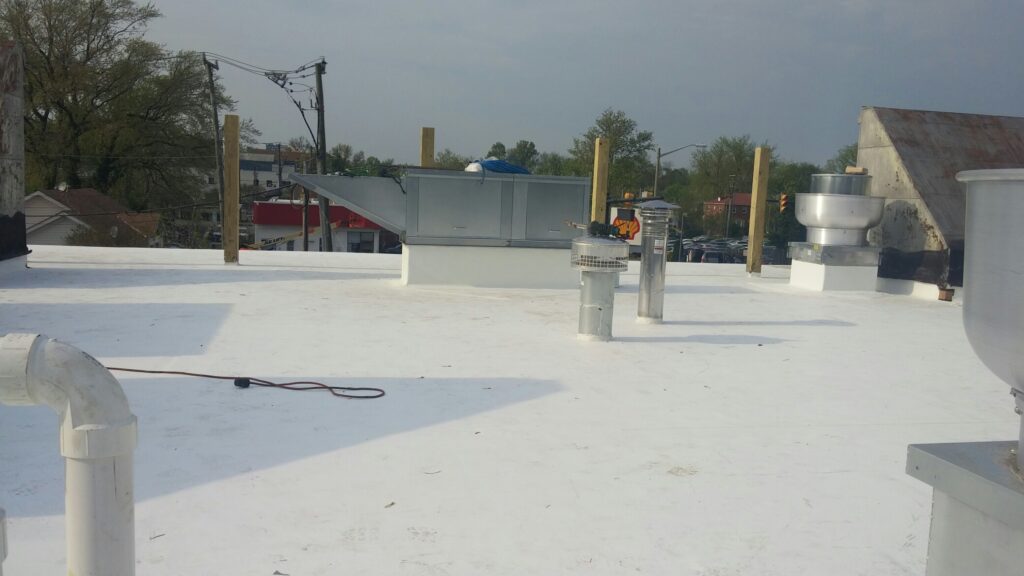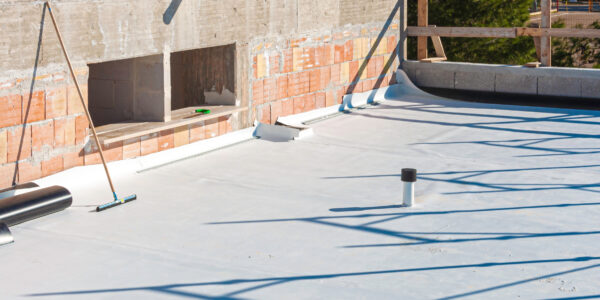TPO Roofing
TPO roofing (Thermoplastic Olefin) is one of the most popular choices for roofing contractors these days. Mostly used on commercial and industrial buildings due to its durability and energy efficiency, TPO roofing is a synthetic polypropylene rubber material that is heat-welded together at the seams to create a monolithic roofing system that protects the building from weather and the elements.
Aside from its superior waterproofing capabilities, TPO roofing looks sleek and clean when freshly installed, and is also a great solution for building owners and property managers looking to make a cost-effective and long-term investment into their commercial roof. The majority of TPO roofs are white in finish, but you can also install options that are gray, tan, and depending on the manufacturer virtually any color you can think of!
Because of the plethora of pre-fabricated accessories available, diversified installation methods, and wide variety of warranty coverages, you’ll no doubt be able to find the right TPO roofing solution for your building’s needs. Of course there are several pros and cons to selecting TPO as a flat roofing choice, most of which we’ll cover on this page.
Benefits of TPO Roofing
There are three main advantages of choosing TPO for a roofing system.
- TPO Roofing Is Energy Efficient: TPO roofing’s chemical make-up and natural white color is known to be outstanding at reflecting the sun’s damaging UV rays, and so it helps buildings keep cool, resulting in reduced energy costs. For properties in most of North America, TPO roofing is a great choice for most climates.
- TPO Roofing is Highly Durable: In addition to protecting the interior of your building from the harmful effects of long term heat aging, UV rays, and ozone exposure, TPO roofing also holds up well against punctures, tearing, and water damage due to it’s scrim reinforcement and heat-welded seams. In addition, TPO offers a fair amount of resistance against hail, making it a sturdy solution for most properties.
- TPO Roofing is Cost-Effective: compared to some other roofing options like EPDM and PVC, TPO is a more affordable single-ply roofing option costing roughly $6-$12 dollars per square foot. Property owners looking to make long-lasting decisions without breaking the bank will find TPO roofing’s return on investment very favorable.
- TPO Roofing Installation Options: compared to other types of flat roofs TPO has a wide variety of installation methods that meet a variety of aesthetic, budgetary, warranty coverage, and wind uplift performance requirements. You can install your TPO roof using an adhered (“glued”), ballasted (“river rocks”), mechanically fastened, or RhinoBond (heat-induction) method depending on what’s important to you with your finished project.
- TPO Roofing Prefabricated Accessories: One major advantage that all single-ply roofs (TPO included) have over asphaltic systems are the wide variety of prefabricated accessories to make installation a breeze. From prefabricated pourable sealer pockets, to pipe flashings, to universal corners, to T-patches, all of these will help make your TPO roof installation faster, simpler, and frankly more waterproof than if you were to field fabricate everything by hand on the roof.
Limitations of TPO Roofing
TPO Roofing is a Single-Ply
In tropical climates where temperatures can periodically average in the 90s and 100s of degrees Fahrenheit, TPO roofing will not perform as well as desired. Like all roofs, TPO falls victim of long term weathering from the most abundant source of most roof damage, the Sun. The location and climate should be considered when selecting a commodity TPO roofing membrane because, in fact there are more high performance TPO options available for these types of climates and for solar applications (i.e GAF Extreme TPO).
TPO Roofing has a Short Record of Success
Since the 1990’s TPO has been installed on billions of square feet of flat roof across the USA and the world; in fact every year the percentage of roofs that are TPO increases every year. Before we had today’s strict ASTM (American Society for Testing and Materials) standards for TPO there were enough system wide failures in the 90’s and early 2000’s that many architects and other design professionals discontinued TPO until further notice. However, the current formulations seem to be performing well in the field.
TPO Roofing is a Single-Ply
Another downside to TPO is that like other single-ply roofing membranes (EPDM & PVC/KEE) it only has 1 layer of roofing protecting the insulation, decking, and the interior of the building. It is a durable roofing system with a strong puncture resistance and superior waterproofing capabilities; the fact remains that 2 layers of waterproofing protection are generally better than 1. If the structure being re-roofed has many curbs and other penetrations, meaning a lot of foot traffic by individuals and crews for other purposes (i.e HVAC/Mechanical service), then decision makers should consider whether TPO is the right material for the job.
How Long Will TPO Roofing Last?
TPO roofing is a durable option for commercial and industrial buildings, and with proper installation and maintenance, it can last for up to 20 years or more. The lifespan of TPO roofing will vary depending on a variety of factors, such as the quality of the installation, thickness of TPO system installed (ex. 45 mil vs 80 mil), the local climate, and the level of maintenance and professional care provided. Therefore, coordinating with a reputable commercial roofer to perform routine preventative maintenance is paramount.
Regular inspections, prompt repairs, and routine cleaning and maintenance can help prolong the serviceability of a TPO roof by several years. Keep in mind that TPO roofs hold up well against ponding water because of the heat-welded seams. However, dark areas of the roof (like those caused by stagnant water) can cause sections of the roof to prematurely fail; this is because those areas attract more heat to the TPO field sheet causing them to wear out faster. Therefore, it is important to make sure that the TPO roofing system’s drainage points are cleaned regularly and that any low lying or flat areas that are causing ponding water are addressed.
How Does TPO Roofing Compare To Similar Options?
TPO is similar to many other flat roofing systems and membranes – and to the untrained eye – it can be very hard to tell the difference between them without additional information. However, the way the materials perform will determine the advantages and disadvantages of each type of roofing material.
PVC Roofing (polyvinyl chloride)
This type of thermoplastic roofing is similar to TPO in terms of energy efficiency and durability with the added benefit of better chemical resistance, but it is more expensive. Both PVC and TPO roofs are recyclable and environmentally friendly. TPO roofing is a smart, cost-effective, durable, and energy-efficient option for commercial and industrial buildings. However, it has limitations, such as sensitivity to heat and protection only as good as a single-layer roofing can provide, so it’s important to consider your local climate and building needs before making a decision.
EPDM Roofing (ethylene propylene diene monomer)
EPDM is a thermoset rubber roofing system that is installed using taped seams. While EPDM has been in service longer than TPO and is considered to be a good flat roof option, the fact remains that the majority of EPDM membranes are not reinforced, and with taped seams they are a less durable system. This also means they are more susceptible to punctures and tears, and with chemically bonded seams require more consistent maintenance. Finally a majority of EPDM roofs are dark in color, meaning they attract more heat and are a less energy efficient roof option. However, you can opt for a white EPDM roof so long as you’re willing to pay a steep premium on the roofing materials and accessories.
Built-up roofing (BUR)
BUR roofing is one of the more traditional roofing options that involves applying layers of hot asphalt and fiberglass felts to create a roof membrane with 4-5 layers of waterproofing protection for a 20+ year warranty. This is one of the more labor-intensive roofing options available. Built up roofing has a service track record dating back 100+ years, which lends to its reliability. Keep in mind that labor is a major driver of the final cost of a roofing project, so the expense should be considered when making a decision.
Modified Bitumen (Mod Bit)
Also known as “rolled” roofing, is a type of asphaltic roof material that is modified with either plastic or rubber for additional flexibility and reinforced with polyester or fiberglass for added puncture resistance. It can expand and contract better than BUR and only requires 2 layers of redundancy for a 20-year warranty. While the seams aren’t as strong as a TPO it definitely has a higher level of puncture resistance. Property owners that want a system that doesn’t require quite as much intensive up-keep may want to look at TPO instead.

Contact Us for Your Free Roof Estimate
With over 60 years of experience, our technicians are ready to take on any roofing challenge. You can count on us to get your rubber roofing project job done right. We’re happy to talk more about our rubber roof replacement services and all of your options when it comes to single-ply roofing. Give Colbert Roofing Corporation a call at (703) 552-9143 or fill out our online form to schedule your free roof estimate!

